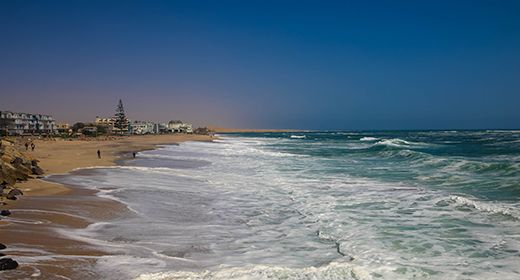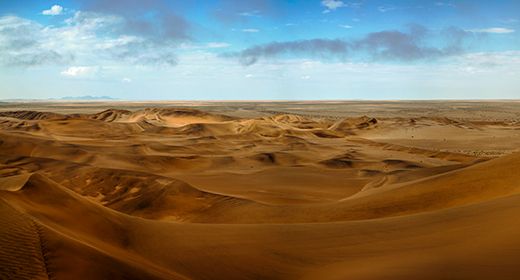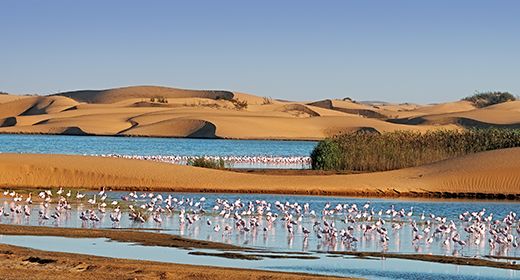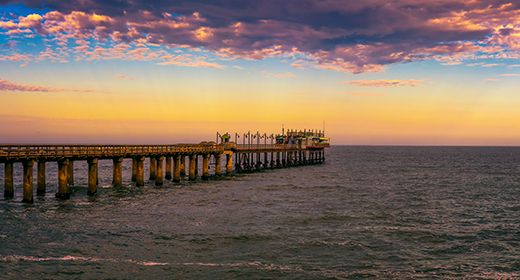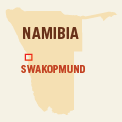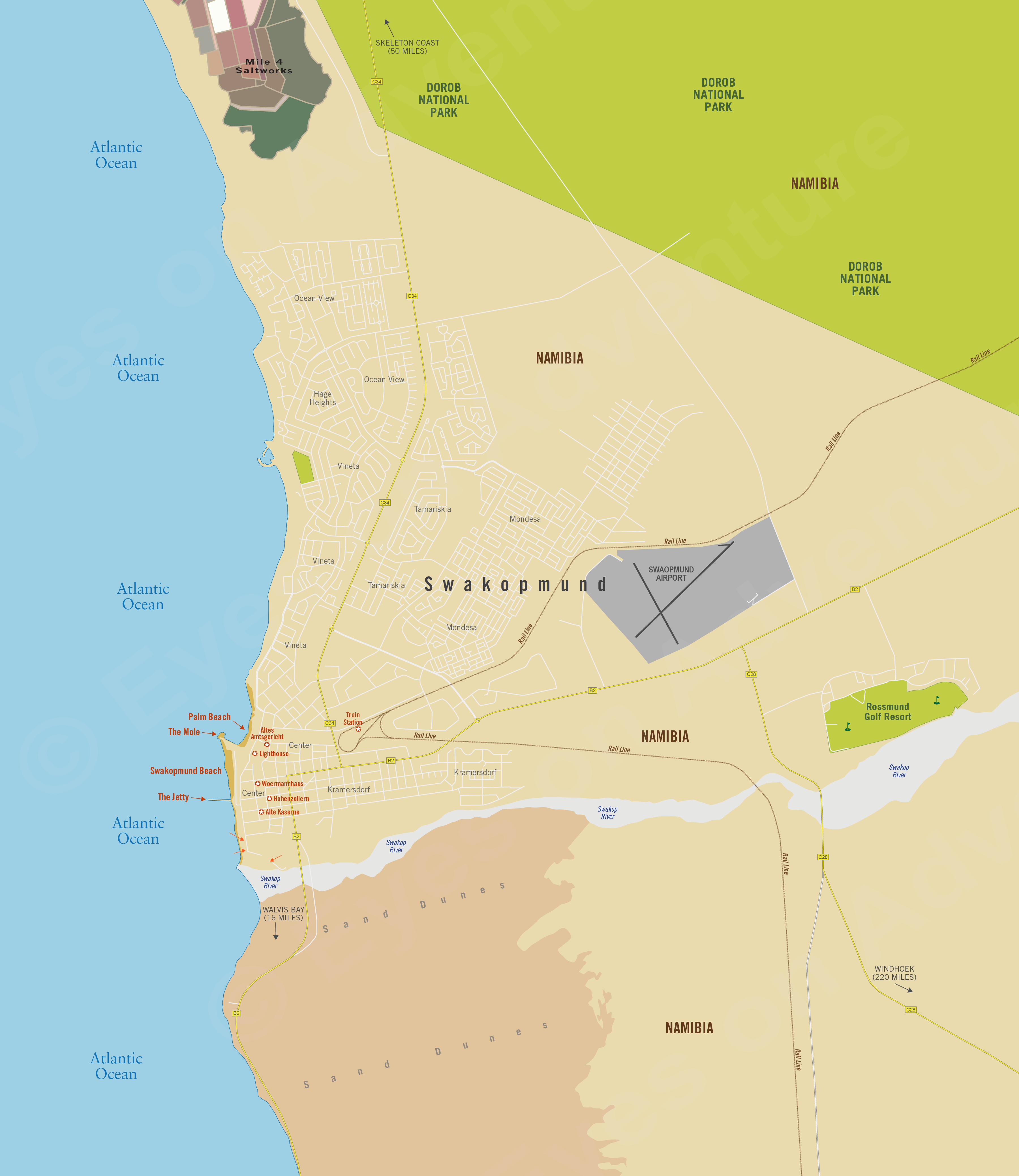Swakopmund
Region Links: Caprivi / Zambezi, Damaraland & Waterberg, Etosha, Namib Desert & Sossusvlei, Skeleton Coast, Kaokoland & Kunene, Swakopmund, Windhoek
Highlights
- Explore this unique destination where massive sand dunes meet the Atlantic Ocean coast
- Tour the historic town and its well-preserved examples of German colonial architecture
- Experience the multitude of adventure activities like sandboarding, quadbiking, dune hikes, more
- Visit nearby Walvis Bay Lagoon for flamingos in the desert or the Cape Cross fur seal colony
EOA Recommends: SeaSide Hotel and Spa, Swakopmund Hotel
Despite having almost 1 000 miles of coastline, Swakopmund is Namibia's only real beach resort destination. It's unique location between desert and ocean make it a spectacular place to visit.
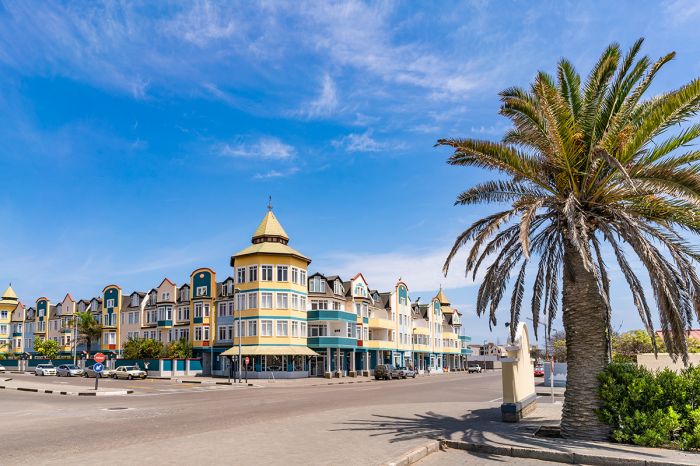
Palm tree and colorful architecture in Swakopmund, Namibia
German settlers first arrived here in the late 19th century and the town has retained its European influence and charm, with lovely colonial architecture, a seaside promenade, sidewalk cafés, and friendly locals.
Swakops, as it is known locally, is a surreal place to visit, with its charming European feel contrasting with its a mix of ethnic residents and its interesting location, sandwiched between the Atlantic Ocean and the incredible 'sand dune sea' of the Namib Desert.
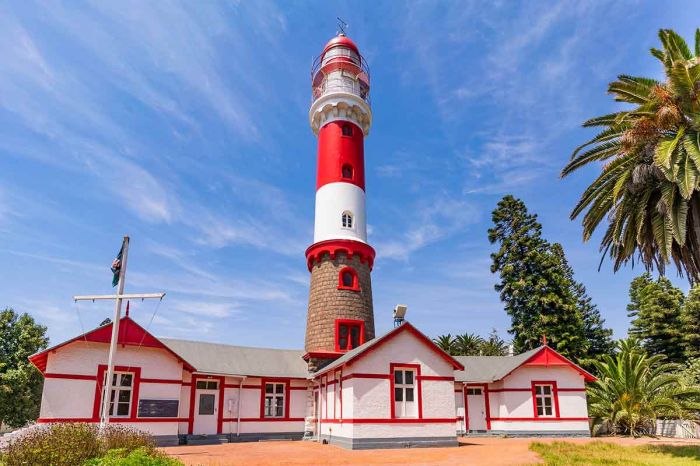
The Swakopmund Lighthouse, built in 1902
Walvis Bay, located only 16 miles south along the coast, is easily explored on a day trip from Swakops. Sandwich Harbor at Walvis Bay has spectacular bird life, including flamingos. Most visitors stay in Swakops, which is the more lively and interesting of the two towns.
Swakops and Walvis Bay are known as Africa's 'second adventure capital' (after Victoria Falls). Adventure activities here include climbing to the top of massive red dunes, sand boarding, kayaking, quad biking, dune buggying, paragliding, horseback riding, skydiving, and more.
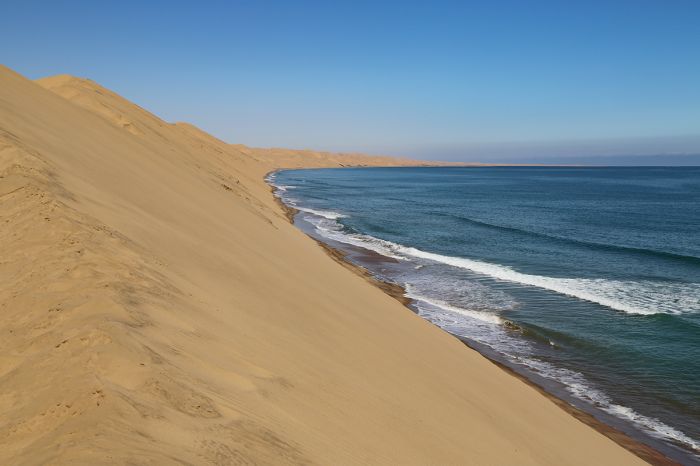
Massive sand dunes meet the ocean at Swakopmund
This historic German settlement, with its palm-lined streets, historic architecture, relaxed feel, outdoor activities, and spectacular setting, make it worthy of a few days on any Namibian itinerary.
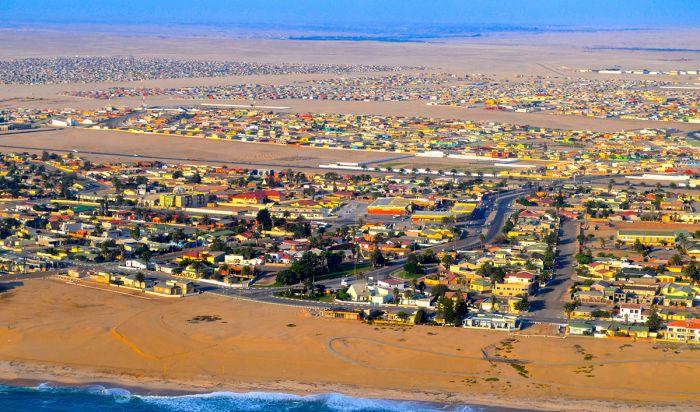
Aerial view over Swakopmund, Namibia
Read More...
Activities, History, Outside Swakopmund, Sights
History
The first humans known to inhabit the area around the Swakop River mouth were the Nama, one of the ethnic groups of Khoikhoi pastoralist people.
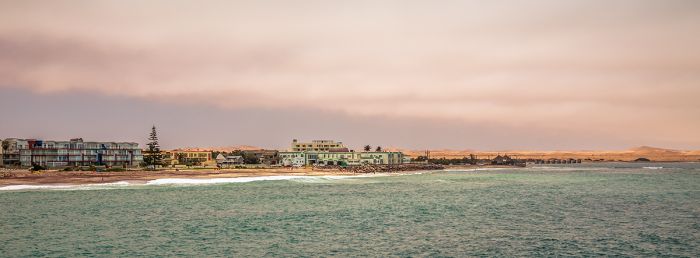
View of the southern end of Swakopmund with the sand dune sea beyond
In 1884, the entirety of present-day Namibia was declared a protectorate of Germany. The only exception was Walvis Bay, the only substantial natural harbor along the coast, which had already been annexed by the British Cape Colony in 1878. In order to further their interests in the region, Germany needed their own harbor and chose the northern bank of the Swakop River for its location.
In 1892, Captain Curt von François founded Swakopmund harbor for the Imperial German colony by erecting two beacons on the shore. The availability of fresh water (from the Swakop River bed) made it more attractive than other potential sites further north, such as Cape Cross. However, the site was far from ideal, with no natural protection for ships at anchor.
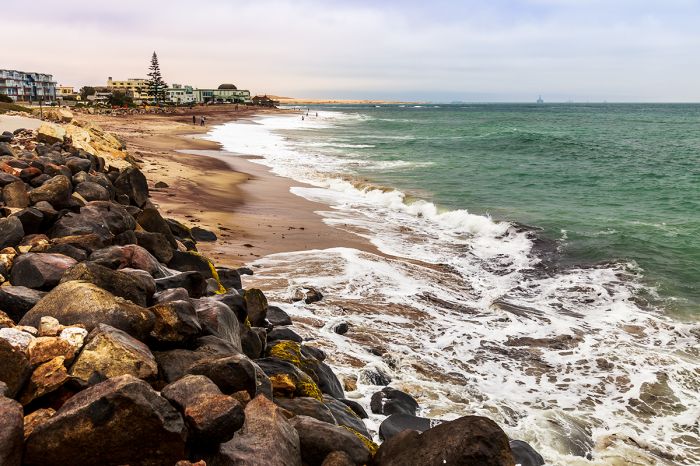
Swakopmund beach and the desert dunes at the edge of town
Von François commanded the Schutztruppe, the German military unit sent to maintain order in the new protectorate. In September 1892, the first 120 troops and 40 settlers arrived at Swakopmund, and they were forced to dig caves into the sand dunes for shelter. Contruction was immediately initiated on Swakopmund's first building, the Alte Kaserne ("Old Barracks"), to house the troops.

View of "the Mole" and Swakopmund town
In 1899, a sea wall (known as 'the Mole') was designed and built by architect FW Ortloff to create a sheltered area for large transport ships to moor. Unfortunately, Ortloff underestimated the effects of the northward moving Benguela Current along the coastline, which carries a heavy load of sand and silt from the Orange river far to the south. The result was that within five years, the artificial harbor had silted up, closing off the entry to ships. Two years later, the entire harbor became inundated by sand, creating what is today called Palm Beach. Today the mole is used as a viewpoint for tourists and a mooring for small boats.
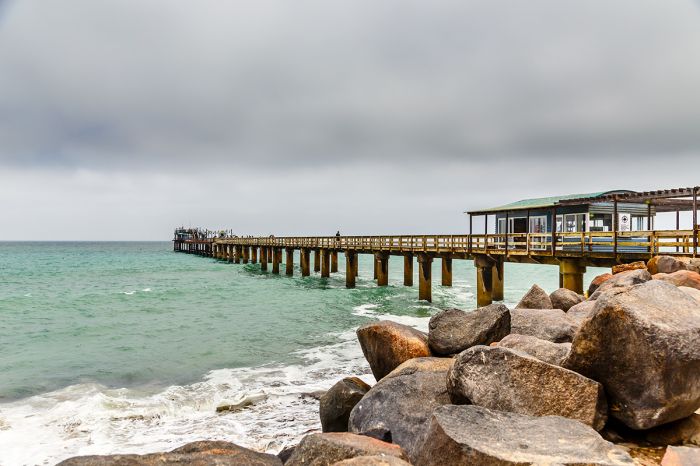
The Jetty at Swakopmund, built in 1911
In 1905, a wooden jetty was built to provide a better landing point for passengers and small cargo shipments. High seas, pounding waves and woodworm infestation soon rendered the pier unusable. In 1911, construction began on a larger iron jetty, which was never completed, but still stands today.
Initially, homes for the German settlers were prefabricated in Germany and shipped to Swakopmund. By 1909, the town had become a busy port and one of only six colonial towns in German South West Africa to be granted municipal status. The port became the main import/export point for the entire German territory and Swakopmund grew in size with workers, governmental agencies, and shipping companies establishing roots.
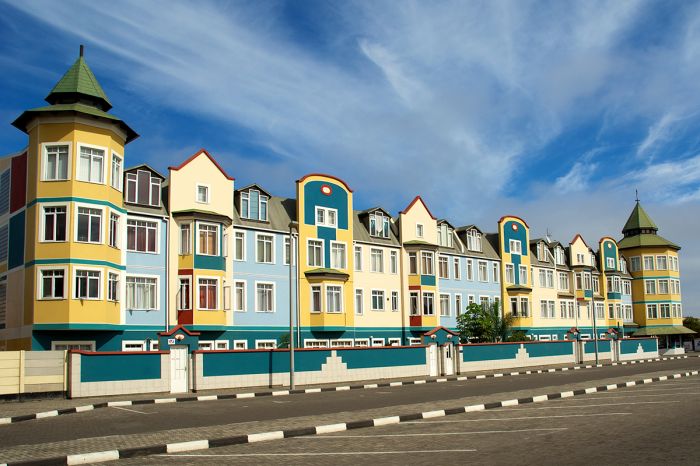
Residential buildings in Swakopmund
After World War I ended, a League of Nations mandate granted administration over South West Africa to Great Britain, with South Africa becoming the acting administrator. All maritime activity shifted from Swakopmund to Walvis Bay, which was still under British control, and the Swakopmund harbor fell into disuse. Ultimately, this is what led to Swakopmund becoming a holiday destination, while Walvis Bay maintained its more commercial status.
Namibia gained independence in 1990, but Walvis Bay remained under South African control until 1994, when it officially became part of Namibia.
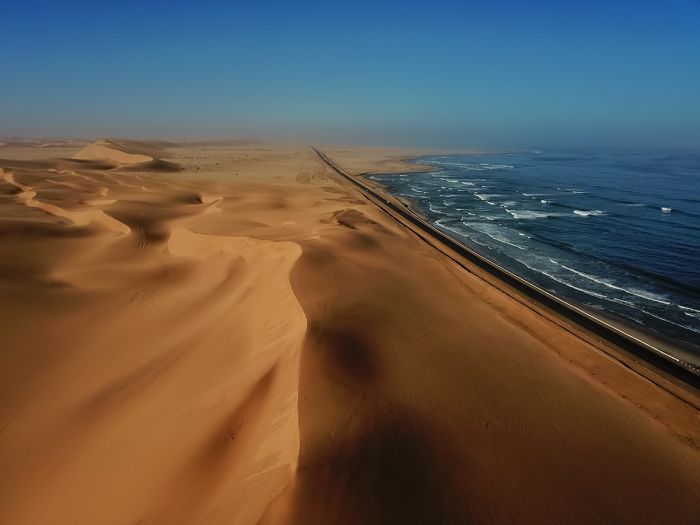
Looking south from Swakopmund over the dune field
Sights
Swakopmund has a retained its distinctly non-African feel, with numerous landmark buildings from the early days of German colonialism. Most of the early German architecture still stands and is in perfect condition. City tours, both guided and self-guided, are a great way to experience the history of this unique town. Following are some of the notable buildings and structures worth visiting.
Alte Kaserne: Swakopmund's first building (its name translates to "Old Barracks"), was built in between 1892-1905 to house the Schutztruppe, the German military engineers unit that maintained order in the territory. Today it is a Youth Hostel.
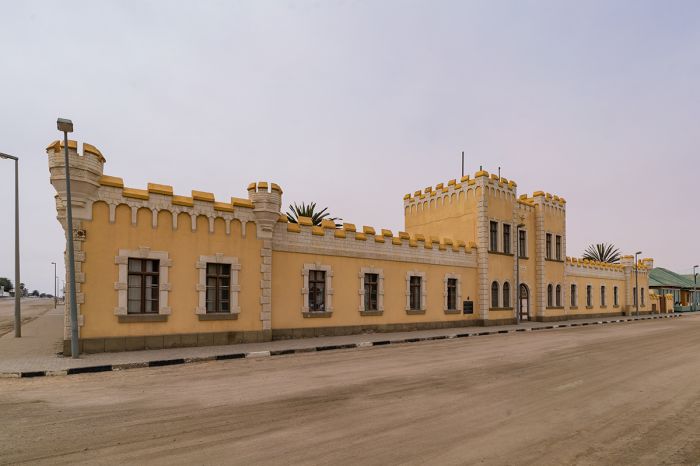
Alte Kaserne (the "Old Barracks") built in 1892
Woermannhaus: Originally constructed in 1894, this beautiful originally served as the main offices for the Damara & Namaqua Trading Company. It was subsequently purchased by the Woermann & Brock Trading Company. It's tall tower, easily visible from offshore, served as a navigation point for the ships of the Woermann line. In the 1920s, it was converted to a school dormitory and later became a hostel for merchant sailors. It eventually fell into disrepair, but was declared a national monument in 1976, restored and is now used as an art centre.
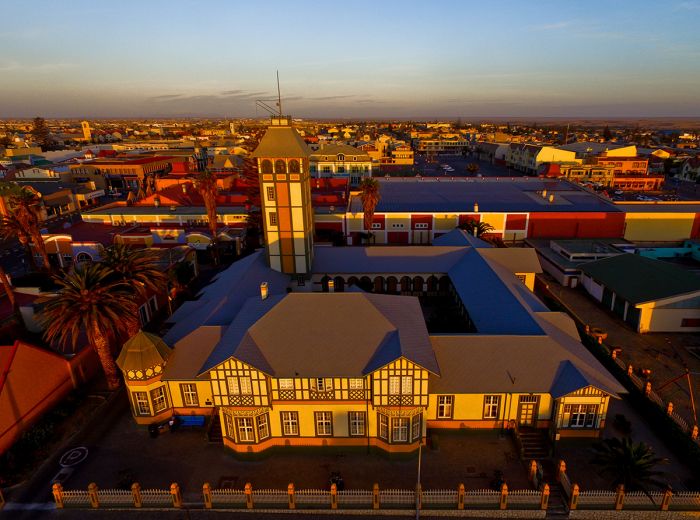
Woermannhaus in Swakopmund, built in 1894
Bahnhof: The ornate "Old Railway Station", designed by Carl Schmidt and built in 1901, served as the railway terminal for the Kaiserliche Eisenbahn Verwaltung (Imperial Railway Authority). The rail system connected Swakopmund to Windhoek in the interior. It was declared a national monument in 1972 and restored to its original charm in the 1990s. Today it is part of the Swakopmund Hotel & Entertainment Centre.
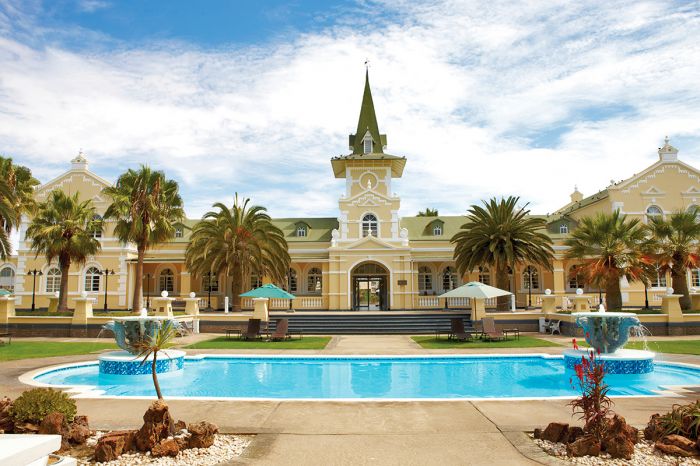
The renovated "Old Railway Station" is now a hotel
Hohenzollernhaus: This Baroque-style building was designed and constructed in 1906 by Hermann Dietz for use as a hotel. Many of the craftsmen who worked on the building's facades and ornamental stucco were from Croatia. Atop the front of the building is a figure of Atlas supporting the world on his shoulders.
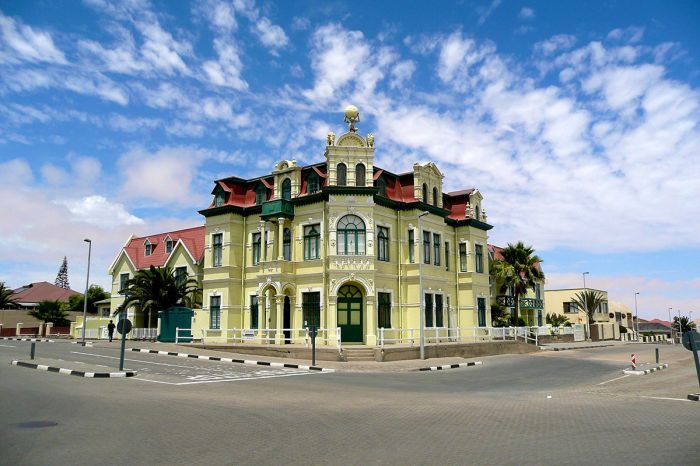
The Hohenzollernhaus, constructed in 1906
Altes Amtsgericht: This lovely, gabled building, whose name means "Old Magistrates' Court", was built in 1908 and served as a private school and later as a courthouse. In the 1960s it was a dormitory and today it is occupied by municipal government offices.
Kaiserliches Bezirksgericht: The "State House" was constructed in 1901 and originally served as the district courthouse. After World War I, it became the official holiday home of the South African territorial administrator. Today it is the official Swakopmund home of the president of Namibia.
Lighthouse: Swakopmund's lighthouse was constructed in 1902 to a hight of 36 feet. An additional 30 feet were added in 1910.
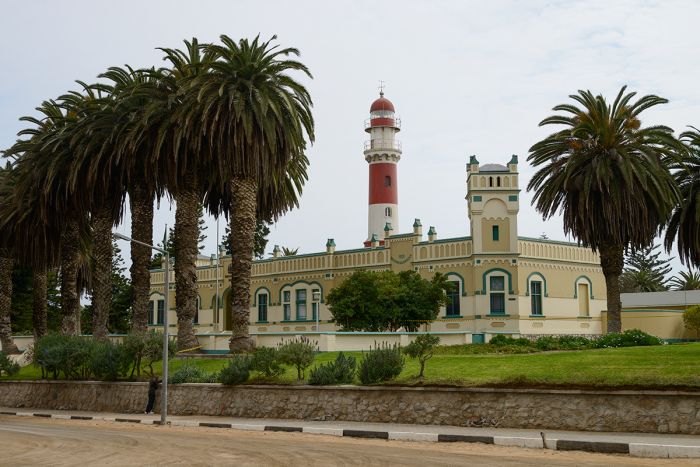
The Bezirksgericht ("State House") with the Swakopmund Lighthouse behind
The Mole: The mole is the name given to the sea wall constructed in 1899 in an effort to create a safe morning harbor for ships. See more details above.
The Jetty: First built in 1905 out of wood and later replaced by an iron version, this landmark still stands against the rough seas. See more details above.
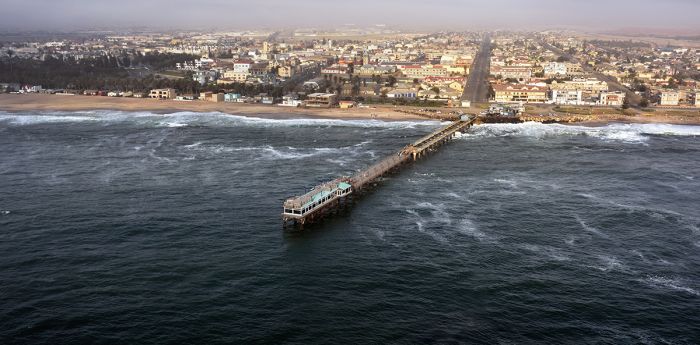
The Swakopmund Jetty and a view over the town
Activities
Swakopmund (and its neighbor Walvis Bay) are known for being Africa's "other" adventure capital (after Victoria Falls). The spectacular red sand dunes that begin on the south bank of the Swakop River continue south to Walvis Bay and far beyond. The desert and dunes are the setting for most the land-based activities.
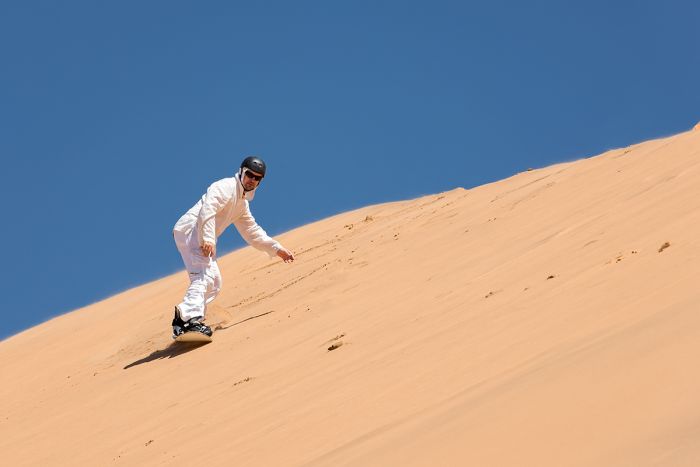
Sand boarding on the dunes at Swakopmund
Quad-biking on the massive dunes (like a scene out of Star Wars), sand boarding (like snow boarding), sky diving (which includes a scenic flight), dune buggy rides, desert tours, camel treks, or just hiking in the "sand sea" are all on offer.
Horseback riding along the ocean, is another popular activity. A variety of city tours are definitely worthwhile to learn about Swakopmund's rich history and see the beautiful colonial architecture. A standard city tour is by vehicle and some walking, but cycling tours are also available.
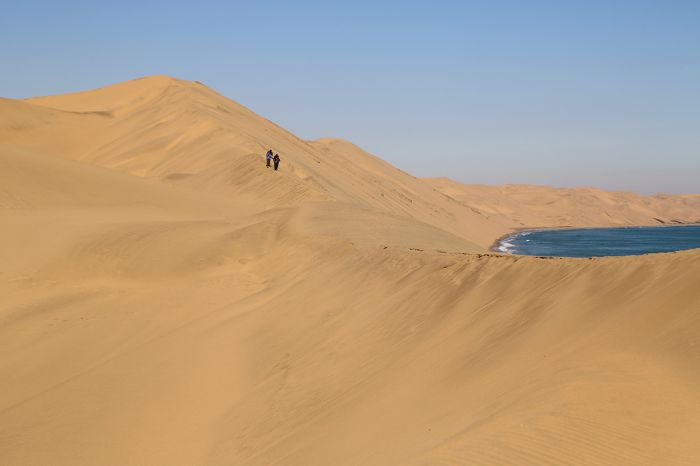
Exploring the dunes around Swakopmund, Namibia
Outside Swakopmund
There are several places worth considering for tours outside of town. The Cape Cross Seal Reserve is located 80 miles (130 kms) north and protects one of the world's largest colonies of Cape fur seals. The reserve is easily reached in under 2 hours' drive.
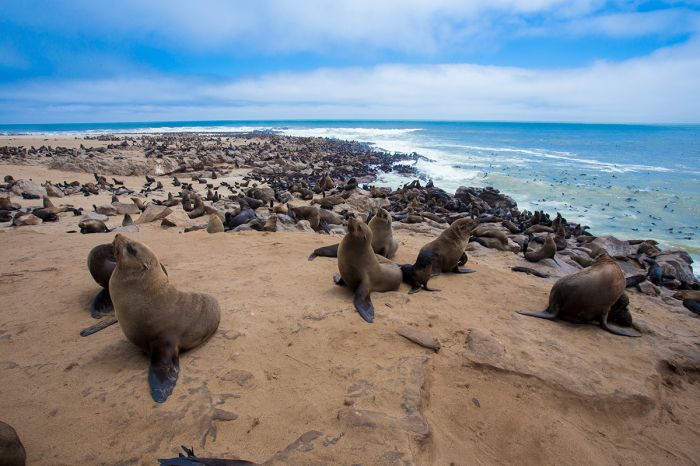
The Cape fur seal colony at Cape Cross
The Mile 4 Saltworks, located just north of the town, is an interesting place to see and photograph. Sea salt is harvested here by allowing sea water to fill large pans, after which it evaporates and leaves behind the lovely sea salt. The area is also home to large numbers of seabirds, including cormorants and flamingos.
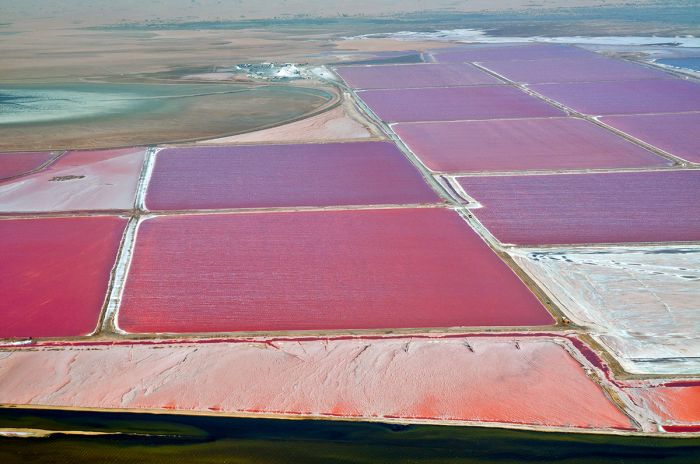
The salt pans north of Swakopmund
Walvis Bay is located only 16 miles south of Swakopmund and is certainly worth a visit to visit the town and see the harbor. Walvis Bay Lagoon and the nearby salt pans are regarded as the most important coastal wetland in Southern Africa, with upwards of 150 000 migrant birds spending the summer months here. Over 150 species have been recorded here, with large numbers of greater and lesser flamingos, gulls, terns, plovers, and more.
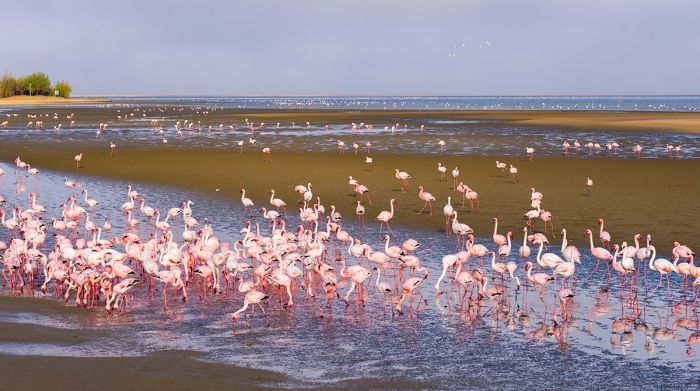
Large flock of flamingos at the Walvis Bay Lagoon
An interesting day tour is a visit to Welwitschia Plain, located about 30 miles east of Swakopmund. Here you will see many examples of the incredible Welwitschia mirabilis, a curious plant that only grows on the gravel plains of the northern Namib Desert. These plants grow very slowly and are known to live for well over 1 000 years, only flowering for the first time at 20 years of age. Tours to this region also visit the lichen fields, the 'Moon Landscape', and the Goanikontes farm, which dates to 1848.
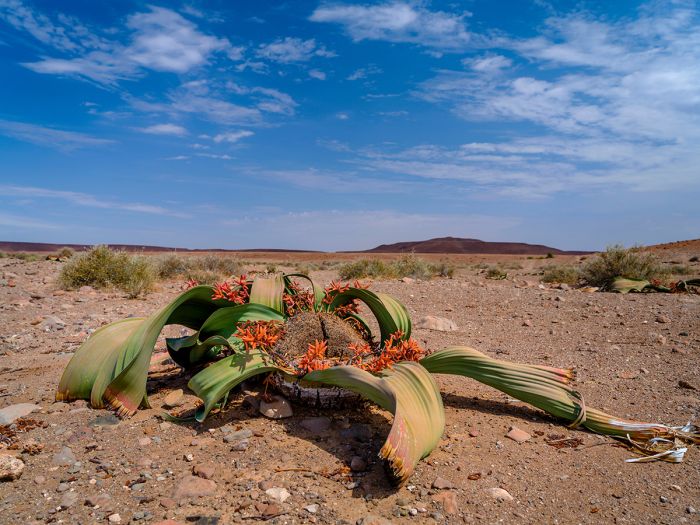
A Welwitschia mirabilis plant
Read More...
Great Good Fair Poor
- Jan
- Feb
- Mar
- Apr
- May
- Jun
- Jul
- Aug
- Sep
- Oct
- Nov
- Dec
Year-Round Destination
Swakopmund and Walvis Bay are year-round destinations. Both towns are situated on the edge of the Namib Desert, but their location on the Atlantic Ocean coast means that temperatures here are much milder than much of Namibia.
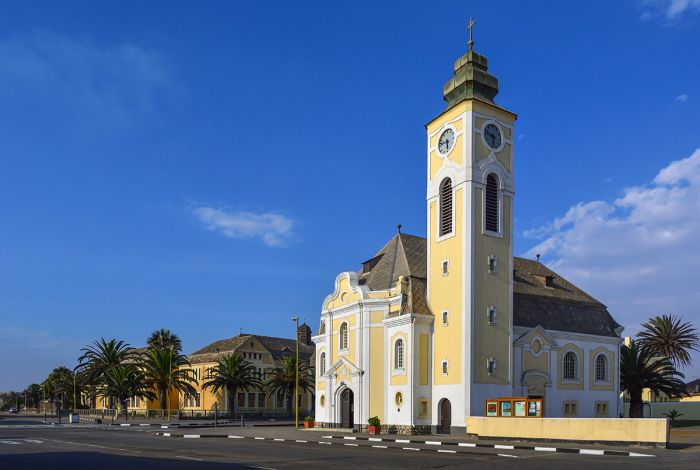
The German Evangelical Lutheran Church in Swakopmund
The Benguela Current, which carries cold water north along Namibia's coast, causes early morning fog on most days. The fog is formed when the cold ocean water meets the hot desert air, but it usually burns off my mid-morning.
Swakopmund becomes very crowded with locals from Windhoek and South Africa during the major holidays, especially Christmas through the New Year and over Easter week. Avoid a visit during this time. Outside of the holidays, both Swakopmund and Walvis Bay are fairly quiet, but booking accommodations and tours ahead of time is still recommended.
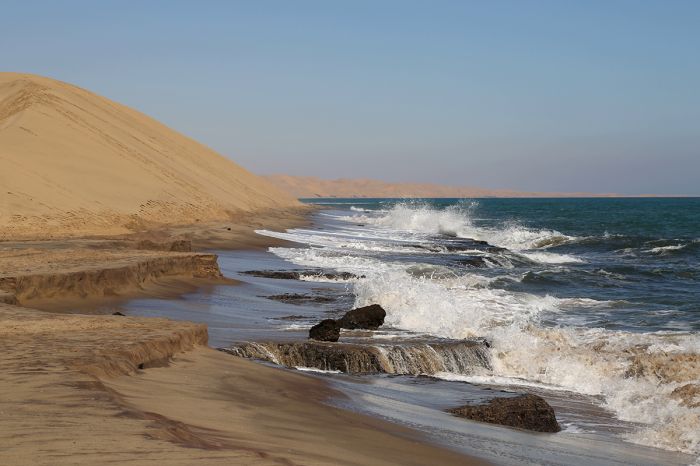
The "dune sea" begins where the town ends at Swakopmund
Rain
Rainfall in Swakopmund and Walvis Bay is almost nonexistent. May thru October is bone dry and November thru April are the only months with a possible chance of rain, but even then, precipitation only averages 2-3mm (one-tenth inch) per month.
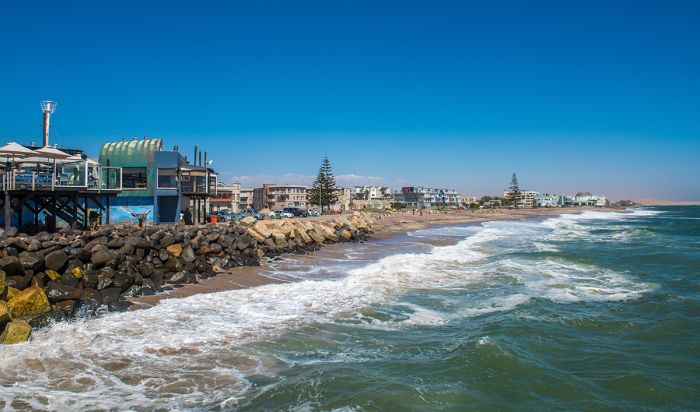
Waves crashing on the southern shore of Swakopmund
TEMPERATURE
November thru June are the warmest months, with average daytime temps of 60-65°F (15-18°C), max temps of 70-74°F (21-23°C), and overnight lows of 49-56°F (10-13°C).
July thru October are the coolest months, with average daytime temps of 55-57°F (13-14°C), max temps of 66-69°F (19-20°C), and overnight lows of 43-47°F (6-8°C).
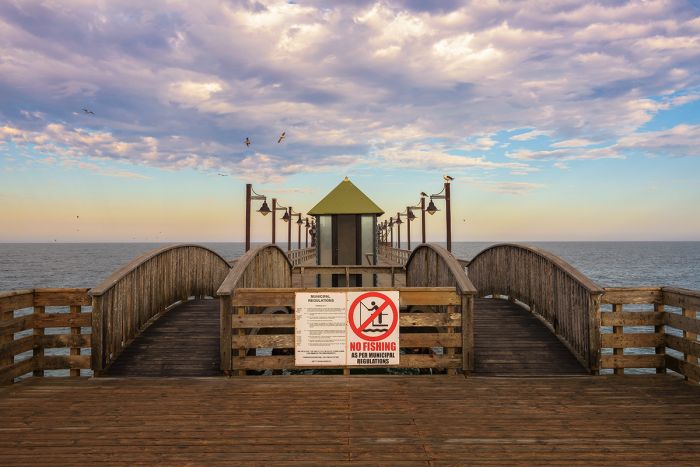
Looking down the old jetty in Swakopmund, Namibia




